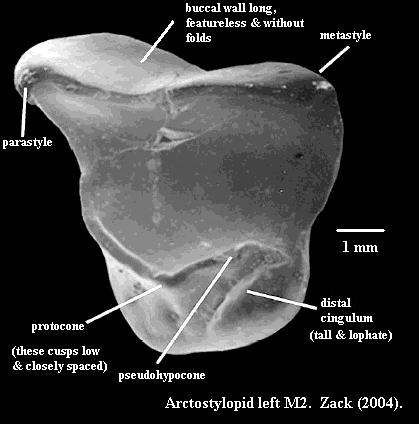
| Palaeos |  |
Laurasiatheria |
| Vertebrates | Eparctocyona |
| Page Back | Unit Home | Unit Dendrogram | Unit References | Taxon Index | Page Next |
| Unit Back | Vertebrates Home | Vertebrate Dendrograms | Vertebrate References | Glossary | Unit Next |
|
Abbreviated Dendrogram
EUTHERIA |--EUARCHONTAGLIRES |?--CHIROPTERA `--LAURASIATHERIA |?--INSECTIVORA `--Ferungulata |--+--FERAE | `--Pholidota `--+--+--Phenacodontidae | `--PERISSODACTYLA `--Eparctocyona |--+--Arctostylopida | `--+--Triisodontidae | `--+--Mesonychia | `--CETARTIODACTYLA `--Bulbulodentata |--Hyopsodontidae `---MERIDIUNGULATA |
Contents
Overview |
Eparctocyona: cows > horses.
Range: from the Late Cretaceous
Phylogeny: Ferungulata : (Perissodactyla + Phenacodontidae) + * : (Arctostylopida + (Triisodontidae + (Mesonychia + Cetartiodactyla))) + Bulbulodentata. [2]
Characters: $ paraxonic pes (pes III & IV about equal length) [SM98]; $ lumbricales (see note) muscles reduced or absent [SM98] [1]; $ "incus crus breve is longer than crus longum" (beats me! please email if you know what this one means) [SM98].
Note: [1] the m. lumbricales are intrinsic muscles of the hands & feet originating in the palm and inserting on the radial side of the metacarpals (or -tarsals). They are responsible for flexing the digits at the metacarpo-phalangeal joint and extending the digits at the interphalangeal joints for digits II-V. This undoubtedly explains why cows and whales do not use hand puppets or wave "bye-bye." [2] I've seen various references equating Eparctocyona with Cetartiodactyla, presumably from folks who have forgotten the South American archaic ungulates and the like. Cetartiodactyla is, as the name suggests, the crown group cows + whales. This is the -- much more inclusive -- stem group: cows > horses.
Links: Taxonomicon.
References: Shoshani & McKenna (1998) [SM98]. ATW060320
 Arctostylopida:
Allostylops, Arctostylops, Asiostylops, Bothriostylops, Gashatostylops,
Kazachostylops, Palaeostylops, Sinostylops.
Arctostylopida:
Allostylops, Arctostylops, Asiostylops, Bothriostylops, Gashatostylops,
Kazachostylops, Palaeostylops, Sinostylops.
Range: Late Paleocene to Early Eocene of China, Mongolia, Central Asia & North America
Phylogeny: Eparctocyona :: (Triisodontidae + ((Mesonychia + Cetartiodactyla)) + *.
Characters: molars with relatively hypsodont crowns, especially buccally [Z04]; buccal wall of crown featureless, without buccal cingulum or folds at ectoloph cusps [Z04]; crown elongate & longer buccally than lingually [Z04]; protocone & pseudohypocone small & closely appressed [Z04]; distal cingulum tall & lophate [Z04]; crown inflated at lingual basal margin [Z04]; specialists in fibrous and/or abrasive vegetation [Z04].
Links: Arctostylopida (Mikko); pal4 (list); Species Skull Ht Lt Wt Time Range Acama probably Acamana U ... (dates & locations); AN EARLY EOCENE ARCTOSTYLOPID (MAMMALIA- ARCTOSTYLOPIDA) FROM THE ... (Zack, 2004).
Note: These are early mammals of rather uncertain affinities. It is by no means certain that they are even ungulates [Z04].
References: Zack (2004) [Z04]. ATW060320.
Triisodontidae: Eoconodon, Triisodon.
Range: early to middle Paleocene of North America.
Phylogeny: Eparctocyona ::: (Mesonychia + Cetartiodactyla) + *.
Characters: By far the largest mammals in the early Paleocene. Massive jaws; strong canine teeth (at least some degree of carnivory); heavily built, blunt, crushing cheek teeth; flattened claws instead of nails.
Links: Paleocene mammals of the world; Paleocene mammals of the world; Transitional Vertebrate Fossils FAQ: Part 2B. ATW010512.
| Page Back | Unit Home | Page Top | Page Next |
checked ATW040213; this page MAK120717